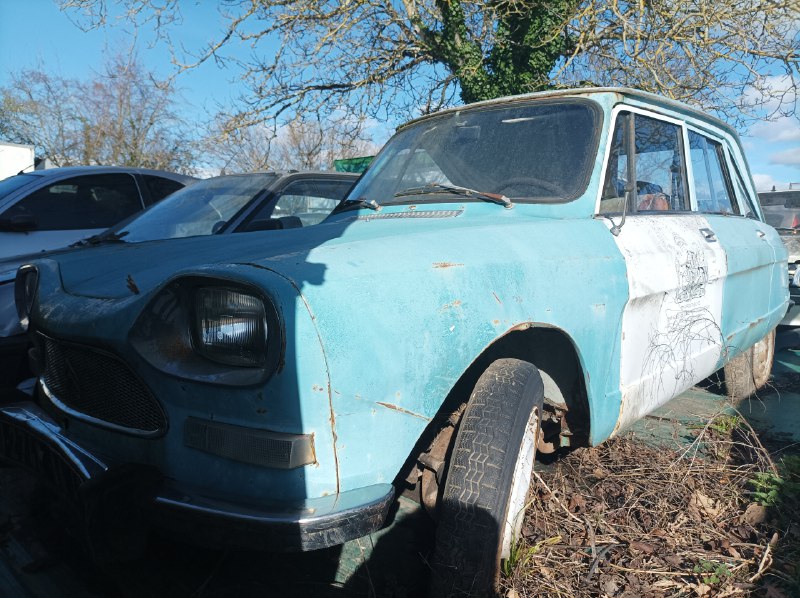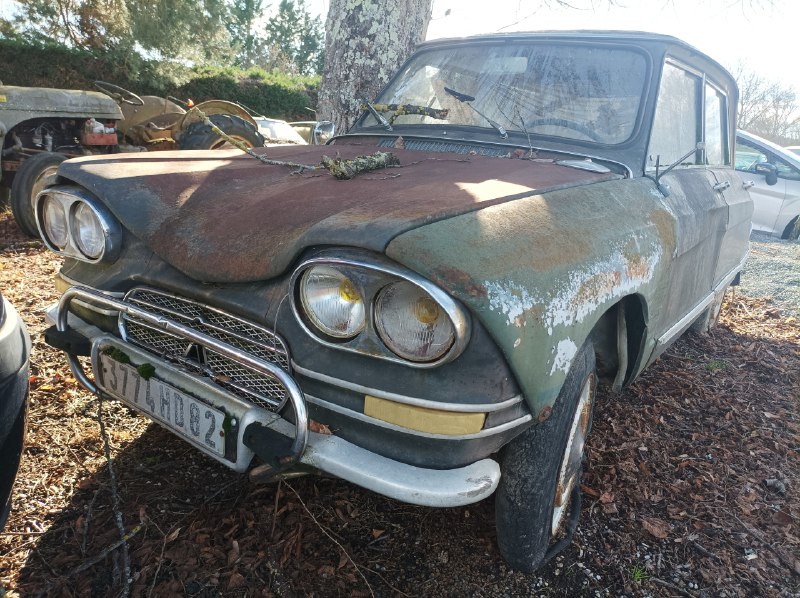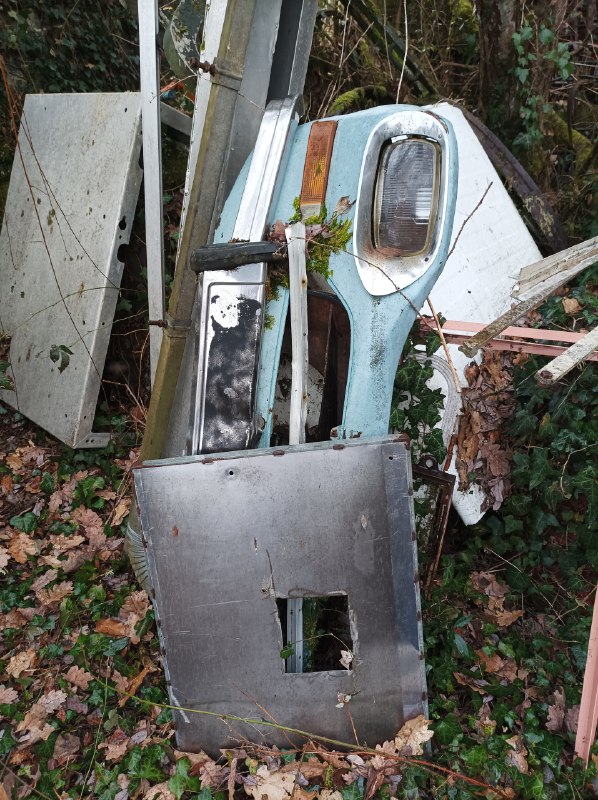The Citroën Ami was Citroën's response to demand for a 'mid-spec' small family car, positioned between the 2CV and the DS.
In 1956 production of the Citroën Traction Avant ended and Citroen was only offering 2 vehicles (3, counting the Type H): The very low-end 2CV, and the very high end luxury DS. It was decided that they needed a new car to fill the large niche between the two existing models.
Because of the technical and economical constraints, the research bureau assigned to the task of engineering the car steered the project towards making it some sort of "super 2CV"; Many years later the Citroen Dyane would reuse the same formula, using parts from the Ami as well.
One design constraint was for the car not to look too 'utilitarian' like the fake hatch-back of the 2CV. In the 2CV, rear seat passengers had to lean forward when entering the car because of the slope of the roof. It was suggested to counter this fault that the rear windshield of the new car would be slanted back, much like the 1959 Ford Anglia 105E.
The 425cc, 21hp Citroen 2CV boxer engine was modified to 602cc, 24hp to power the heavier, wider new car. Later versions of the 602cc would reach 32hp.
The Ami 6 would be released in 1961 and sold well despite flaws (steel body panels being too thin, water gutters on the roof dripping over the windshield, windshield wipers obstructing the driver's view...).
For the last year of production, a special edition was released called "Ami 6 Break Club", with quad round optics, chrome side strips, special hubcaps and adjustable seats. (Picture 4)
Production of the Ami 6 would end in 1969 with little over 1 million cars, to give way to the redesigned Ami 8; the reverse-slant rear windshield replaced with a fastback line on the sedan version. The ami 8 would stop production with 800,000 cars.
➡️@CarScraps
In 1956 production of the Citroën Traction Avant ended and Citroen was only offering 2 vehicles (3, counting the Type H): The very low-end 2CV, and the very high end luxury DS. It was decided that they needed a new car to fill the large niche between the two existing models.
Because of the technical and economical constraints, the research bureau assigned to the task of engineering the car steered the project towards making it some sort of "super 2CV"; Many years later the Citroen Dyane would reuse the same formula, using parts from the Ami as well.
One design constraint was for the car not to look too 'utilitarian' like the fake hatch-back of the 2CV. In the 2CV, rear seat passengers had to lean forward when entering the car because of the slope of the roof. It was suggested to counter this fault that the rear windshield of the new car would be slanted back, much like the 1959 Ford Anglia 105E.
The 425cc, 21hp Citroen 2CV boxer engine was modified to 602cc, 24hp to power the heavier, wider new car. Later versions of the 602cc would reach 32hp.
The Ami 6 would be released in 1961 and sold well despite flaws (steel body panels being too thin, water gutters on the roof dripping over the windshield, windshield wipers obstructing the driver's view...).
For the last year of production, a special edition was released called "Ami 6 Break Club", with quad round optics, chrome side strips, special hubcaps and adjustable seats. (Picture 4)
Production of the Ami 6 would end in 1969 with little over 1 million cars, to give way to the redesigned Ami 8; the reverse-slant rear windshield replaced with a fastback line on the sedan version. The ami 8 would stop production with 800,000 cars.
➡️@CarScraps
❤7👍1
group-telegram.com/CarScraps/543
Create:
Last Update:
Last Update:
The Citroën Ami was Citroën's response to demand for a 'mid-spec' small family car, positioned between the 2CV and the DS.
In 1956 production of the Citroën Traction Avant ended and Citroen was only offering 2 vehicles (3, counting the Type H): The very low-end 2CV, and the very high end luxury DS. It was decided that they needed a new car to fill the large niche between the two existing models.
Because of the technical and economical constraints, the research bureau assigned to the task of engineering the car steered the project towards making it some sort of "super 2CV"; Many years later the Citroen Dyane would reuse the same formula, using parts from the Ami as well.
One design constraint was for the car not to look too 'utilitarian' like the fake hatch-back of the 2CV. In the 2CV, rear seat passengers had to lean forward when entering the car because of the slope of the roof. It was suggested to counter this fault that the rear windshield of the new car would be slanted back, much like the 1959 Ford Anglia 105E.
The 425cc, 21hp Citroen 2CV boxer engine was modified to 602cc, 24hp to power the heavier, wider new car. Later versions of the 602cc would reach 32hp.
The Ami 6 would be released in 1961 and sold well despite flaws (steel body panels being too thin, water gutters on the roof dripping over the windshield, windshield wipers obstructing the driver's view...).
For the last year of production, a special edition was released called "Ami 6 Break Club", with quad round optics, chrome side strips, special hubcaps and adjustable seats. (Picture 4)
Production of the Ami 6 would end in 1969 with little over 1 million cars, to give way to the redesigned Ami 8; the reverse-slant rear windshield replaced with a fastback line on the sedan version. The ami 8 would stop production with 800,000 cars.
➡️@CarScraps
In 1956 production of the Citroën Traction Avant ended and Citroen was only offering 2 vehicles (3, counting the Type H): The very low-end 2CV, and the very high end luxury DS. It was decided that they needed a new car to fill the large niche between the two existing models.
Because of the technical and economical constraints, the research bureau assigned to the task of engineering the car steered the project towards making it some sort of "super 2CV"; Many years later the Citroen Dyane would reuse the same formula, using parts from the Ami as well.
One design constraint was for the car not to look too 'utilitarian' like the fake hatch-back of the 2CV. In the 2CV, rear seat passengers had to lean forward when entering the car because of the slope of the roof. It was suggested to counter this fault that the rear windshield of the new car would be slanted back, much like the 1959 Ford Anglia 105E.
The 425cc, 21hp Citroen 2CV boxer engine was modified to 602cc, 24hp to power the heavier, wider new car. Later versions of the 602cc would reach 32hp.
The Ami 6 would be released in 1961 and sold well despite flaws (steel body panels being too thin, water gutters on the roof dripping over the windshield, windshield wipers obstructing the driver's view...).
For the last year of production, a special edition was released called "Ami 6 Break Club", with quad round optics, chrome side strips, special hubcaps and adjustable seats. (Picture 4)
Production of the Ami 6 would end in 1969 with little over 1 million cars, to give way to the redesigned Ami 8; the reverse-slant rear windshield replaced with a fastback line on the sedan version. The ami 8 would stop production with 800,000 cars.
➡️@CarScraps
BY Auto Archaeology







Share with your friend now:
group-telegram.com/CarScraps/543
